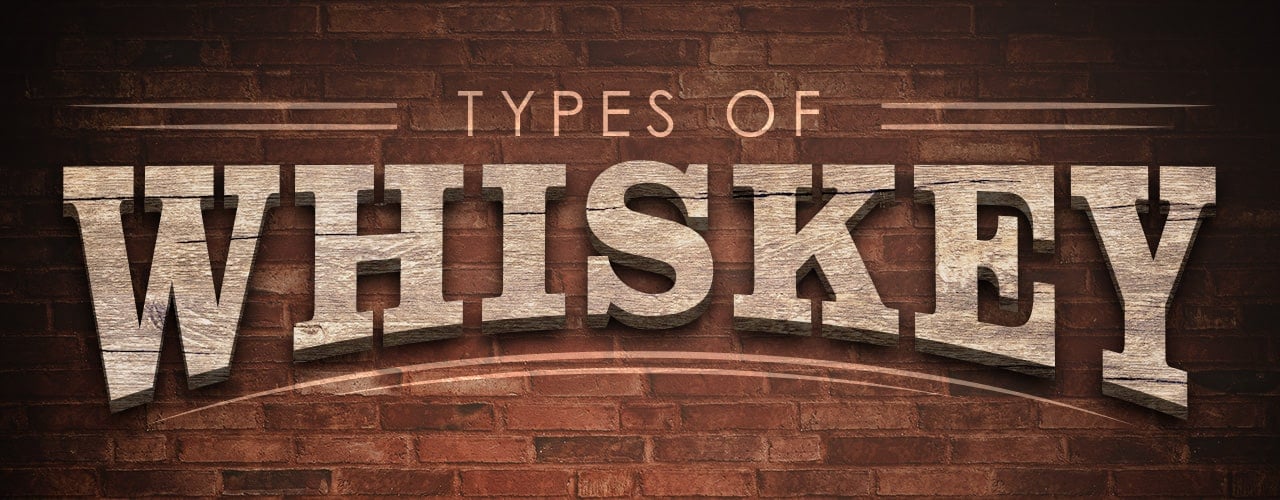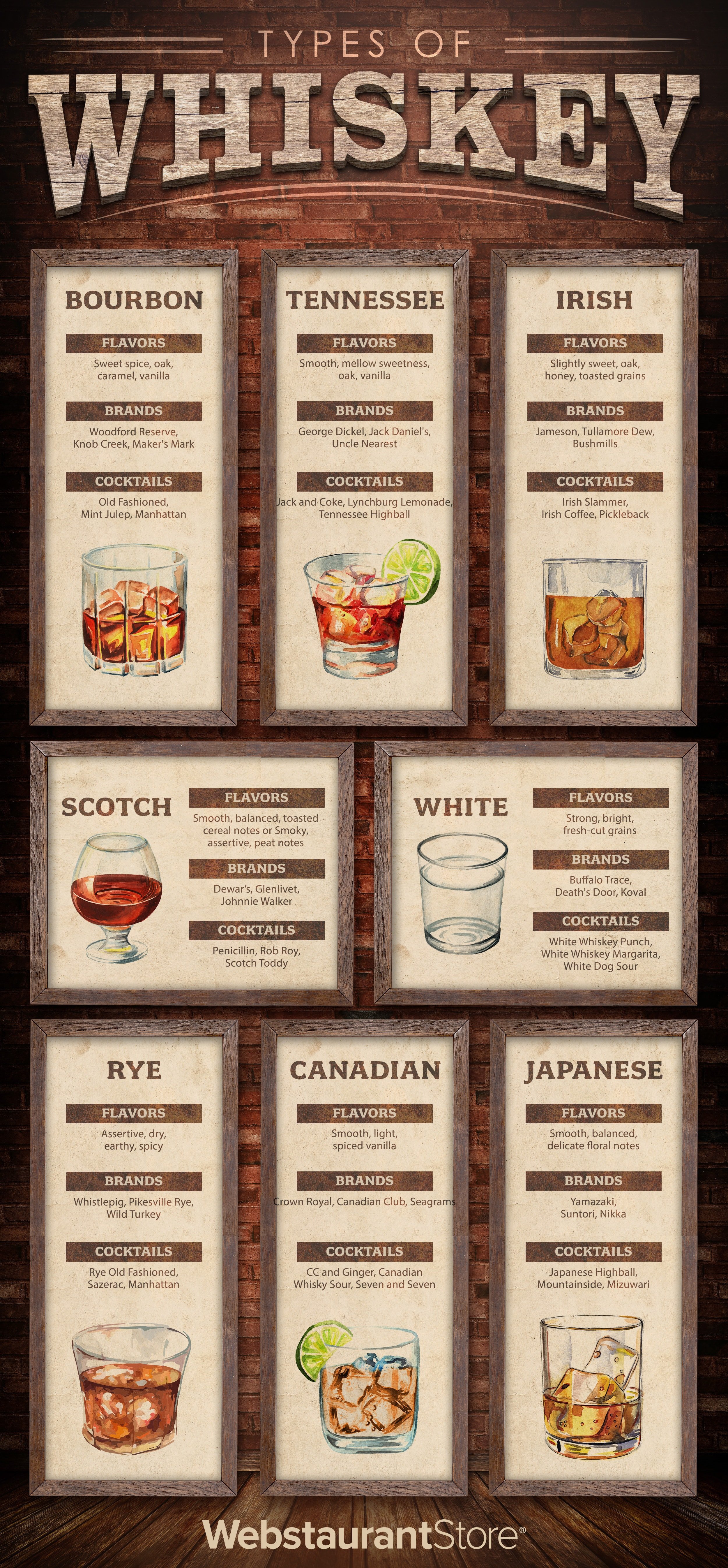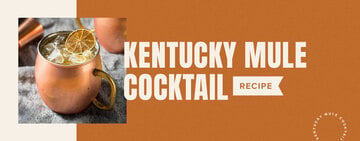
To keep your business well-stocked with bar essentials and appeal to the whiskey lovers of the world, it's good to have some foundational whiskey knowledge. Most fans of this complex spirit gravitate towards a specific type of whiskey and are loyal to certain brands. Whether you're making an Old Fashioned or discussing the merits of single malt scotch, knowing the differences between types of whiskey goes a long way. In this article, we'll explain all things whiskey so you can identify the main differences between the types and use this information to your advantage.
Shop All Whiskey GlassesWhat Is Whiskey?
Whiskey is a barrel-aged alcoholic spirit made from grains like barley, rye, corn, or wheat. It sounds simple, but there are different types of whiskey, all with their own labeling requirements, distillation methods, and flavor profiles. Some whiskeys have sweet notes, and some are more assertive in flavor. Certain whiskeys are meant to be served neat, and some benefit from a drop of water. You'll even see some types of whiskey spelled differently. Whiskey, with an "e," is typically used for Irish whiskey and many American whiskeys. On the other hand, whisky, without the "e," is reserved for Scotch whisky and any whisky made in the Scottish tradition, such as Canadian and Japanese whiskies.
Different Types of Whiskey
Our detailed list will help you identify the flavor profiles of different types of whiskey, as well as the strict labeling requirements associated with each type:
1. Bourbon Whiskey

We'll begin with one of the most well-known types of American whiskey: bourbon. Bourbon is made with corn mash, which makes it sweeter than whiskeys made with other grains. The corn produces caramelized notes of maple syrup and warm honey. After barrel aging in charred oak barrels, the flavor becomes more layered with notes of spice and vanilla. Bourbon can be enjoyed neat or with a drop of water, but one of the most famous bourbon cocktails is the Kentucky Mint Julep.
Bourbon whiskey is an American whiskey made with at least 51% corn mash. To be classified as bourbon, the spirit must also be produced in the United States and aged in new white oak barrels. Barrels cannot be reused between batches; they must be brand new, freshly charred, and unused. Famously, bourbon comes from Kentucky, but it can technically be made anywhere in the country.
What Is Straight Bourbon?
To be marketed as a straight bourbon, the spirit must be aged for a minimum of two years in the required new oak barrels. Straight bourbon contains no colorings, flavorings, or additives besides water.
What Is Corn Mash?
Corn mash is the signature ingredient of bourbon. It’s made from crushed corn kernels, malted barley, water, and yeast. After these ingredients are combined, the mash is heated to start the fermentation process. Mash can be made from a variety of grains or even fruits, but bourbon is strictly made with 51% corn mash.
- What Does Bourbon Taste Like? Sweet and woodsy with notes of oak, caramel, and vanilla
- Bourbon Whiskey Brands: Woodford Reserve, Knob Creek, Maker's Mark
- Bourbon Whiskey Cocktails: Old Fashioned, Mint Julep, Manhattan
2. Tennessee Whiskey

Just like bourbon, Tennessee whiskey is made from a mash that contains at least 51% corn. It has the same caramel-like sweetness of bourbon, but additional filtering mellows out the taste by removing some of the more assertive alcohols and esters. The strong corn flavor of the whiskey is also softened, allowing other flavor notes to shine through.
Tennessee whiskey can be classified as a type of bourbon whiskey, but it has some additional requirements that make it unique. First of all, it has to be produced in the state of Tennessee. Secondly, Tennessee whiskey must be filtered through charred maple wood chips before aging. This step is called the Lincoln County process, charcoal leaching, or charcoal mellowing.
- What Does Tennessee Whiskey Taste Like? Sweet and mellow with notes of oak, maple, and vanilla
- Tennessee Whiskey Brands: George Dickel, Jack Daniel's, Uncle Nearest
- Tennessee Whiskey Cocktails: Jack and Cola, Lynchburg Lemonade, Tennessee Highball
3. Rye Whiskey

Rye is a type of whiskey with a sharp, peppery bite that is starkly different from whiskey made with other grains. American rye whiskey is made with 51% rye grain mash, which imparts a dry, earthy flavor instead of the sweet caramel flavor produced by corn mash. But just like bourbon, rye whiskey must be distilled in the US and aged in new oak barrels. To be labeled as straight American rye, the whiskey has to be aged for at least 2 years and contain no additives.
Rye vs Bourbon Old Fashioned
The Old Fashioned is a famous whiskey cocktail that can be made with bourbon or rye. It all comes down to the customer’s whiskey preference. Rye will produce an Old Fashioned that is spicy and dry, which is balanced by the sweetener used in the drink, usually a sugar cube. On the other hand, bourbon has a sweet flavor already, so less sugar can be used and sometimes the bitters are increased. The Manhattan cocktail is another mixed drink that can be made with either bourbon or rye to create a different flavor profile.
Canadian Rye vs American Rye
America isn’t the only country with a love for rye whiskey. Rye is also produced in Canada, but it differs from American rye whiskey. Instead of using a mash made primarily from rye, Canadian rye whiskey is made from other grains with just a small amount of rye added for flavor.
- What Does Rye Whiskey Taste Like? Assertive, dry, earthy, spicy
- Rye Whiskey Brands: Whistlepig, Pikesville Rye, Wild Turkey
- Rye Whiskey Cocktails: Rye Old Fashioned, Sazerac, Manhattan
4. Scotch Whisky

To be labeled scotch, the whisky must be made in Scotland from primarily malted barley and aged at least 3 years in oak casks. Single malt scotch must be made from 100% malted barley and produced in a single distillery. The flavor profile of scotch is determined by the region where it was produced, the barrels used for aging, and whether the whisky is single malt or blended.
Peat Scotch
Peat plays a huge role in Scottish whisky production and contributes to the strong, earthy flavors of single malt scotch. But what is peat, and what does it have to do with whisky? Peat is a type of plant matter that forms from decomposing moss and other vegetal growth in the bogs (or peatlands) of Scotland. The Scottish tradition is to dry barley over smoked peat before making the mash, which adds assertive notes of tar, ash, and smoke. Peat is formed from plant matter local to the area, which is why regional distilleries in Scotland each have their own signature flavor.
Unpeated Scotch
Not all Scotch whisky is peated. There are single malts produced without smoked peat, which allows other flavors from the malted barley or wood barrels to shine through. Unpeated scotch may exhibit sweet, fruity, or chocolate notes.
- What Does Scotch Whisky Taste Like? Blended Scotch may be smooth, balanced, and sweet; Single malt Scotch may be smoky, peaty, and assertive; Unpeated single malt may be malty, fruity, and biscuity
- Scotch Whisky Brands: Dewar's, Glenlivet, Johnnie Walker
- Scotch Whisky Cocktails: Penicillin, Rob Roy, Scotch Toddy
5. Irish Whiskey

Irish whiskeys are likely to be triple distilled, lending a soft, smooth mouthfeel to the spirit that makes it easy to sip. It’s also common for Irish whiskeys to be made from barley dried in a closed kiln, which doesn’t add the smoky flavor associated with scotch. The types of barrels used in maturation also add more complex flavors to whiskey as it ages. Irish whiskey is known for being less sweet than bourbon and more mellow than scotch.
Irish whiskey can be difficult to define because of the experimentation at play with modern distilleries. One of the simplest requirements is that Irish whiskey must be produced in Ireland. It must be made with a mash that contains malted barley and aged in wooden casks for at least 3 years. To be labeled Irish whiskey, the spirit must contain no additives other than water and caramel coloring. Many Irish whiskeys are blended, but there are also Irish single malts, grain whiskeys, and pot still whiskeys.
What Is Single Pot Still Whiskey?
Single pot still whiskey is a type of Irish whiskey made with at least 30% malted barley and 30% unmalted barley. The unmalted barley, also called green barley, adds a strong cereal flavor to the whiskey. To be labeled single pot still, the whiskey must also come from a single distillery.
- What Does Irish Whiskey Taste Like? Smooth and slightly sweet with notes of oak, honey, and toasted grains
- Irish Whiskey Brands: Jameson, Tullamore Dew, Bushmills
- Irish Whiskey Cocktails: Irish Slammer, Irish Coffee, Pickleback
5. Canadian Whisky

Traditional Canadian whisky is known for its blending, whether it’s blending batches made from different grains or blending whisky styles from other countries. Canadian whisky blends may even contain percentages of American bourbon or single malt scotch. To help achieve the perfect blend, Canadian distillers use a special technique. They produce a base whisky with a high alcohol content and a flavoring whisky with a low alcohol content. These separate batches are blended to strike the right balance between proof and flavor.
To be labeled as Canadian whisky, the spirit must be made in Canada and aged for at least 3 years in wooden barrels. The barrels can be new or used, and the mash can be made with any cereal grain. Caramel color and up to 9.09% additional flavorings can also be added. These relaxed requirements make room for distilleries to experiment with different grains and blends.
- What Does Canadian Whisky Taste Like? Smooth and light with spicy notes of vanilla
- Canadian Whisky Brands: Crown Royal, Canadian Club, Seagram's
- Canadian Whisky Cocktails: CC and Ginger, Canadian Whisky Sour, Seven and Seven
7. Japanese Whisky

Japanese whisky is known more for its innovation than for a particular style. The Japanese method of distillation was borrowed from the Scottish tradition, but there are aspects of the process that Japanese distillers have chosen to refine. For one, Scottish distilleries depend on one or two still sizes and shapes, but Japanese distillers experiment with different still sizes and shapes. During barrel aging, the use of a Japanese oak called mizunara wood imparts a range of distinct flavors like citrus, coconut, or sweet spices.
Japan has been producing whisky since the 1920s, but until recently the labeling requirements were not clearly defined. As of April 2021, Japanese whiskies must be produced in Japan and must include malted grain in the mash. Any water used in production must be extracted in Japan, and the spirit must be aged in wooden casks for at least 3 years. No additives besides caramel coloring can be used in the whisky.
- What Does Japanese Whisky Taste Like? Smooth, balanced, delicate notes of smoke, floral, or citrus
- Japanese Whisky Brands: Yamazaki, Suntory, Nikka
- Japanese Whisky Cocktails: Japanese Highball, Mountainside, Mizuwari
Whiskey FAQ
If you want to understand this popular spirit a little better, check out the answers to some commonly asked questions below:
Whiskey or Whisky?
Back in the late 19th century, Irish whiskey distillers decided to add an "e" to whiskey to set their products apart from Scottish distilleries. Since Irish whiskey was a hit in America at the time, American distillers followed suit and adopted the Irish spelling. That's why you'll often see bourbon, Tennessee, and rye whiskeys spelled with the Irish "e." Canadian, Scottish, and Japanese distillers prefer the spelling "whisky."
What Is Single Malt?
Single malt Scotch is basically whisky that comes from one distillery in Scotland and is made from 100% malted barley. Single malts can actually be a blend of different batches from the same distillery, as long as they meet the requirements.
When you sip on a single malt, you're tasting the essence of the distillery and the unique flavors that come from the region where it's made. Think about the peat used to smoke the barley and the type of wood that ages the whisky - it all adds to the charm and artistry of single malts.
What Is Blended Whiskey?
Blended Scotch is a mix of single malt and grain whiskies, which are made from grains like corn or wheat instead of just barley. The goal of blending is to create a consistent flavor that's just right every time. Skilled master blenders work their magic by combining different single malts and grain whiskies to find the perfect balance. Some people think blended whisky is not as good as single malt because it's made with cheaper grains that don't need as much time to mature as barley. But, that's not always the case! Today, there are some top-notch blended whiskies out there that have been crafted with the utmost care and attention to detail.
Types of Whiskey Chart
For a quick visual reference, check out our whiskey chart below:
Whiskey can be a complicated subject to navigate, especially when you factor in the different styles and their devoted fan bases. Now you should be armed with enough information to stock your bar with the finest whiskeys and make educated recommendations to your guests.






